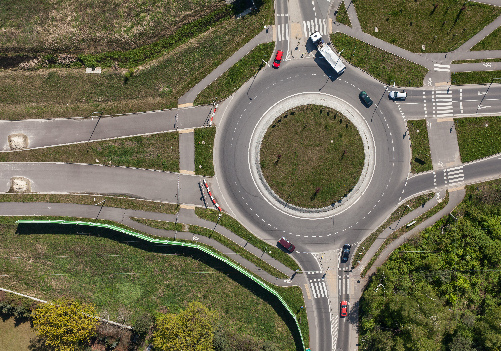
Roundabouts move traffic one-way in a counterclockwise direction, at slower speeds and create fewer conflict points for potential incidents.
This article is from the Spring 2017 issue of The Quill. To view the full issue, visit The Quill archive.
Roundabouts are becoming
more common throughout the United States, replacing the traditional intersection. Roundabouts move traffic one-way in a counterclockwise direction, at slower speeds and create fewer conflict points for potential incidents. Although some motorists may be perplexed when approaching a roundabout, many of the same general rules apply when negotiating a roundabout as other types of intersections.
When approaching a roundabout, drivers should slow their speed, pay attention to signs and lane markings, and then select the appropriate lane for the direction they wish to travel. Traffic should yield to pedestrians and bicyclists, as well as traffic on the left that is already in the roundabout. Drivers should only enter a roundabout when there is a safe gap in traffic, then maintain a reduced speed while within the roundabout. As drivers approach their exit, the right signal should be activated to signal the exit they will be utilizing, while making sure to continue to yield to pedestrians and bicyclists.
In a paper published by the American Transportation Research Institute (ATRI) in 2012, the approach, the circular roadway and the departure were examined for problems that may afflict drivers of large vehicles such as tractor-trailers, buses and straight trucks. Of the three rankings, the circular roadway represented 56% of the potential for “serious problems” as compared to 30% for the approach and 29% for the departure. As roundabouts become more common, companies should include safe navigation of roundabouts in their initial and continued safe-driver training.
Drivers of large vehicles need to take additional steps to ensure safe navigation through roundabouts. Most importantly, drivers of large vehicles are expected to stay in their designated lane when approaching a roundabout. There will be times when a tractor-trailer may track into other lanes and the driver must utilize all available space. The driver of any large vehicle may have to utilize the truck apron, which is the paved area on the inside of the roundabout that was intentionally engineered into the design to be used by large vehicles when off-tracking.
When making a right turn, drivers of large vehicles may need more space than what is provided in the designated lane of travel. In this situation, drivers must be alert to surrounding traffic, pedestrians and bicycles as they enter the roundabout. Once committed to the roundabout, drivers must maintain awareness of their surroundings and proceed with caution until the roundabout has been negotiated.
Prior to entering a roundabout, drivers should select the lane that allows them to keep traffic on the “sight side” of the vehicle, if possible, while permitting them to exit the roundabout where they need to. The driver should check for surrounding obstacles and, when clear, enter the roundabout. The driver must keep in mind that the trailer, or rear of an extended large vehicle, may off-track onto the truck apron. Drivers should continually monitor their mirrors until they are clear of the roundabout.
To help avoid incidents associated with roundabouts, companies should cover safe navigation of roundabouts in initial and ongoing driver training.
Drivers needing to make a through movement, or continue on their current direction of travel, should select the lane that allows them to keep traffic on the left side of their vehicle. Drivers should continually check for surrounding traffic, utilize their mirrors and proceed with caution until they have cleared the roundabout.
Some of the more complex roundabouts are in the shape of a bow tie. With these, you will have a slight curve to the right, then to the left, then to the right, then back to the left which means your vehicle
and/or trailer has the opportunity to off-track several times in a single roundabout, causing exposure to vehicles, pedestrians and fixed objects on both sides
of your vehicle.
As roundabouts continue to become more common throughout the United States, drivers of large vehicles will find themselves navigating them more often. Always be prepared for other drivers to make mistakes in a roundabout. They can happen quickly and without intention. When driving a commercial vehicle, other motorists may unknowingly not give you the extra room that you need, especially if they are not expecting your vehicle to off-track into their lane. To help avoid incidents associated with roundabouts, companies should cover safe navigation of roundabouts in initial and ongoing driver training. Drivers who are well-trained in the safe navigation of roundabouts will be able to do their part in helping to keep our roadways incident-free.
Source: “Roundabouts and the Accomodation of Large Trucks: A Motor Carrier Perspective.” American Transportation Research Institute. http://docs.trb.org/prp/13-3008.pdf